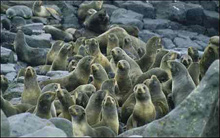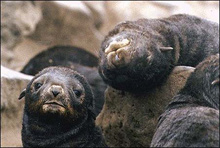North Pacific Fur Seal Treaty of 1911
- Government Interest in Sealing
- Elliott's First Seal Studies
- Moved to Conserve the Herd
- The Treaty as a Landmark
Government Interest in Commercial Sealing

Henry Wood Elliott was one of the first Americans to study the northern fur seal. He worked vigorously on behalf of fur seal conservation.
In 1872 Henry Wood Elliott, a young artist-naturalist, travelled as a U.S. Treasury Department special agent to Alaska’s Pribilof Islands, assigned to study the fur seals and to oversee the fur seal harvest. Since the United States government received substantial royalties from the trade in seal skins, Elliot’s objective was to determine the most profitable manner of managing the great seal herds of the Pribilof Islands for a sustainable harvest. Earlier, in response to widespread seal slaughter and to protect its financial interests, the United States had leased the rights to fur seal harvesting on the islands to the Alaska Commercial Company and declared the open waters of the eastern Bering Sea off-limits to sealers from any nation.
But rather than protecting the seals, these actions led to offshore, open water sealing by other nations, decimating the herd. This slaughter and mismanagement of the fur seal harvest spurred Elliott to work vigorously on behalf of fur seal conservation. His tireless efforts led to the North Pacific Fur Seal Treaty of 1911, the first international treaty for wildlife conservation and a forerunner of the law that gave NOAA stewardship of marine mammals–the Marine Mammal Protection Act of 1972.
Elliott’s First Fur Seal Studies

From a series of sketches by Henry Wood Elliot following his study of fur seals on Alaska's Pribilof Islands in the 1870s. Click image for larger view.
Elliott’s initial studies in 1872 indicated a herd of approximately four million seals. He came back to the Pribilofs in 1874 and 1876 and concluded from his studies that 100,000 bachelor males per year could be harvested without undermining sustainability, “provided no abnormal cause of destruction occurred.”
The most valuable commercial pelts came from the three-year-old bachelor, and it was the three-year-old males that native Aleut harvesters culled out of the herd. Shooting females was particularly destructive as three seals were effectively killed–the female, a nursing pup ashore in the rookeries that relied on the female for food, and a seal embryo. Mismanagement of the land harvesting operations on the Pribilof Islands led to taking females and immature males in the rush to profit.
Moved to Conserve the Herd

A Northern fur seal harem. Click image for larger view.
Elliott returned again to the Pribilofs in 1890. He was outraged at the incompetence and malfeasance of both government officials and commercial interests who allowed the seal herds to be decimated. As a result, he became an untiring advocate of the fur seal. However, the U.S. government and commercial sealing interests were not yet ready for concepts of managed conservation and cooperation between nations to assure marine mammal conservation on the high seas.
In 1905 Elliott, in partnership with U.S. Secretary of State John Hay, drafted a treaty for managing the seal herds. Unfortunately, Hay died and it was not until July 1911 when the four nations most concerned with sealing–Russia, Japan, Great Britain, and the United States–were sufficiently shocked and revolted by the indiscriminate slaughter of the seals to sign a treaty outlawing open water sealing and accepted on-shore management of the seal herds by the United States.
The Treaty as a Landmark in Marine Mammal Conservation

Northern fur seal pups. Click image for larger view.
The Convention between the United States and Other Powers Providing for the Preservation and Protection of Fur Seals, popularly known as the Fur Seal Treaty of 1911, was a landmark agreement. It was the first international treaty to address the issue of wildlife conservation and represented “a major victory for the conservation of natural resources, a signal triumph of diplomacy…, and a landmark in the history of international cooperation.” This treaty led to an act of Congress in 1912 prohibiting any sealing activities for five years which allowed the herd to regenerate. The treaty remained in effect for thirty years until World War II and then was followed by other international agreements and, notably, the Fur Seal Act of 1966.
The Fur Seal Treaty of 1911 served as the model for follow-on diplomacy and legislation. It was the forerunner and inspiration for legislation such as the Marine Mammal Protection Act of 1972, the 1994 amendments to this law, and other legislation guiding the mission and philosophy of NOAA. It also provided the basis for cooperative relationships between NOAA and the Pribilof Island Aleuts tribes to conserve northern fur seals and provide for their subsistence needs, and serves as a model for cooperation between NOAA and many tribal governments today.










